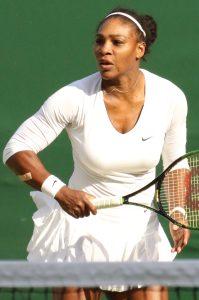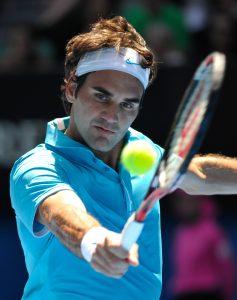We may earn money or products from the companies mentioned in this post.
Definition of a Pusher in Tennis

Tennis is a sport that showcases various playing styles, each with its own unique characteristics One such style is that of the “pusher” In tennis, a pusher refers to a player who relies more on consistency and placement rather than power and aggression
Unlike aggressive players who focus on powerful shots and attacking their opponents, pushers prioritize control and accuracy They employ a defensive approach, aiming to frustrate their opponents by returning shots consistently and forcing them to make errors
General Overview of Pusher’s Playing Style and Tactics

1 Consistency over Power
Pushers prioritize consistency over power in their shots They aim to keep the ball in play for as long as possible, making it challenging for their opponents to hit winners or force errors By relying on consistent and controlled strokes, they minimize unforced errors and increase their chances of winning points through opponent mistakes
2 Effective Court Coverage
Pushers excel at court coverage, using speed and agility to retrieve balls from seemingly impossible positions They have excellent anticipation skills, allowing them to position themselves well before their opponent strikes the ball This enables them to return difficult shots with precision and frustrate opponents who rely on offensive plays
3 Strategic Placement
A key tactic employed by pushers is strategic shot placement Rather than hitting powerful winners, they aim to exploit weaknesses in their opponent’s game by placing the ball strategically away from their comfort zones This forces opponents into uncomfortable positions or awkward shots, increasing the likelihood of errors or weak returns
4 Patience and Mental Strength
Patience is another essential characteristic of pushers’ playing style They are willing to engage in long rallies, waiting for their opponents to make mistakes rather than forcing the issue themselves Pushers understand that maintaining a calm and composed mindset is crucial in outlasting aggressive players who may become impatient or frustrated
5 Adaptability
Pushers are highly adaptable and possess the ability to adjust their game plan depending on their opponent’s strengths and weaknesses They study their opponents’ playing styles, identifying vulnerabilities and adjusting their tactics accordingly This adaptability allows pushers to exploit weaknesses effectively and disrupt opponents’ rhythm
6 Physical Fitness
Physical fitness plays a vital role in a pusher’s success as it enables them to maintain high levels of stamina throughout matches The ability to retrieve balls from all areas of the court requires excellent cardiovascular endurance and agility
In conclusion, while pushers may not possess flashy shots or overpowering serves, they compensate with consistency, strategic shot placement, court coverage, mental strength, adaptability, and physical fitness Their unique playing style challenges opponents by forcing them into prolonged rallies and testing their patience Pushers prove that tennis is not solely about power but also about skillful precision and tactical acumen
Characteristics of a Pusher

Tennis is a game filled with diverse playing styles, and one that often stands out is the pusher Known for their unique approach to the game, pushers have developed a set of characteristics that make them formidable opponents on the court Let’s dive into what sets them apart:
Defensive Playing Style
Unlike power players who rely on aggressive shots, pushers prioritize consistency and placement They understand that winning points isn’t about brute force but rather about wearing down their opponents over time By patiently rallying and relying on their stamina as key attributes, pushers frustrate their adversaries and force errors
Court Coverage and Anticipation Skills
Pushers possess exceptional footwork and speed, allowing them to cover the court with ease Their ability to anticipate their opponents’ shots gives them an edge in positioning themselves for optimal returns This anticipation comes from experience and keen observation, enabling pushers to read their opponents’ intentions before they even strike the ball
Variety of Shots Used by Pushers
Pushers employ a wide array of shots strategically designed to disrupt their opponents’ rhythm They utilize high percentage shots like deep groundstrokes and well-placed lobs to keep their adversaries constantly on the move Furthermore, slice backhands are a favorite weapon for pushers as they introduce unpredictable spin and change of pace, making it challenging for aggressive players to find their groove
Mental Toughness and Strategy
Beyond physical attributes, mental toughness plays a crucial role in a pusher’s game plan Pushers excel at frustrating opponents through relentless shot-making coupled with incredible patience They stay composed even in high-pressure situations, waiting for opportunities to exploit weaknesses in their adversaries’ game By drawing errors from aggressive players, pushers capitalize on their opponents’ overzealousness and turn the tide in their favor
In conclusion, the characteristics of a pusher encompass a unique blend of defensive playing style, court coverage and anticipation skills, a variety of strategic shots, and mental toughness While they may not rely on power or aggression, pushers have mastered the art of outlasting and outsmarting their opponents on the tennis court
Pros and Cons of Being a Pusher

When it comes to tennis, there are various playing styles that players adopt to gain an advantage on the court One such style is being a pusher, which involves a defensive approach with an emphasis on consistency and patience While this style has its advantages, it also comes with its fair share of disadvantages Let’s take a closer look at the pros and cons of being a pusher
Advantages
Being a pusher allows for more margin for error in matches By focusing on reducing unforced errors, pushers can frustrate their opponents by consistently returning shots and extending rallies This not only puts pressure on the opponent but also increases the chances of forcing them into making mistakes
Additionally, being a pusher is well-suited to certain court surfaces, particularly slower courts like clay that reward defensive play The extended rallies on these surfaces give pushers more time to retrieve shots and make it harder for opponents to hit winners With their ability to outlast opponents, pushers can turn matches into grueling battles of attrition
Disadvantages
While being a pusher has its advantages, there are also notable disadvantages that come with this playing style One major difficulty is facing powerful or highly skilled players who can overpower or outmaneuver the pusher Their aggressive shot-making and ability to vary their game can pose significant challenges for a player relying solely on defensive tactics
In addition, being a pusher often means having limited offensive options Creating winners becomes more difficult without resorting to riskier shots or aggressive playstyles Furthermore, when forced into an attacking position by an opponent’s strong shots, the lack of offensive weapons can leave the pusher vulnerable and struggling to regain control
In conclusion, being a pusher in tennis has its advantages and disadvantages While it can provide a safety net of consistency and frustrate opponents, it may struggle against more powerful or skilled players Moreover, the limited offensive options can pose challenges when needing to take control of the match Ultimately, each player must weigh these pros and cons to determine if being a pusher aligns with their playing style and goals
How to Play Against a Pusher

When facing a pusher on the tennis court, it’s crucial to understand their common tactics and adjust your game plan accordingly By recognizing their strategies and implementing specific techniques, you can gain an edge and turn the tables in your favor
Recognizing Common Tactics Employed by Pushers
A pusher is known for their consistent and defensive style of play They rely on keeping the ball in play, forcing their opponents into long rallies and errors It’s important to identify these tactics early on so that you can formulate an effective counter-strategy
Adjusting Your Own Game Plan Accordingly
To combat a pusher’s game, maintaining patience is key Long rallies can be mentally exhausting, but it’s essential to conserve energy for key points Avoid frustration and unnecessary risks that could lead to unforced errors
Varying your shot selection and pace is another effective approach against pushers By mixing in drop shots, slices, and angles, you disrupt their rhythm and force them out of their comfort zone Alternating between aggressive power shots and slower-paced placement shots keeps them guessing about your next move
Attacking the Net When Opportunities Arise
If you find yourself facing a pusher who struggles with net play, this presents a golden opportunity for you By attacking the net when opportunities arise, you force them into uncomfortable positions where they have to make difficult passing shots This puts pressure on them and allows you to take control of the point
Staying Mentally Focused Throughout the Match
A pusher may employ mind games or distractions during a match to throw off your concentration It’s important to overcome these challenges by staying mentally strong and focused on your game plan By remaining composed under pressure, you can outplay and outsmart the pusher
Remember, playing against a pusher requires adaptability and strategic thinking By implementing these techniques, you’ll be better equipped to handle their defensive style of play and emerge victorious on the court
Useful Links

The Pusher’s Strategy is Better Than Yours
Singles Strategy I 5 Tactics To Beat The Tennis Pusher
Pusher. Meaning in tennis. Definition. Wiki. Terms
Three Secrets for Destroying Pushers
How to Beat a Pusher in Tennis? Outsmarting The Pusher
Tennis Player Types
Tactical Tennis: Playing the runner-pusher
Is it fun being a pusher?
What is a Pusher in Tennis?
How To Beat A Pusher In Tennis – John Frausto
what is a pusher tennis
[Blog] 5 Ways to Beat a Pusher
How to Beat a Pusher: 5 Surefire Tactics
How to Beat a Tennis Lobber (aka, the Pusher …
How To Beat Pushers – Tennis Lesson
Distance Learning with Paul & Prakash: How to beat a …
Beating a Pusher
How to Beat a Pusher or Moonballer in Tennis?






